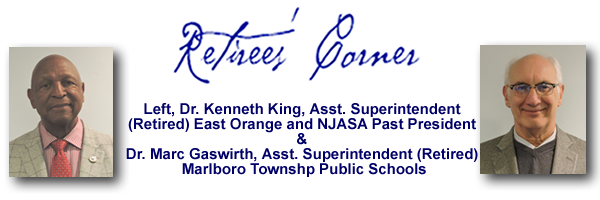- NJASA
- Retiree Corner feb 2020


-
Giving Back
Human resources is an area of school administration that often gets little credit, recognition and/or appreciation until some urgent personnel issue arises. Staff members then immediately turn to the district’s human resources leader to help solve the problem. Having worked in this area for a combined total of more than 80 years, we know that this is often the case.
In many small districts, the human resources function defaults to the chief school administrator and/or his/her secretary. Medium-sized districts may have a human resources office, which is generally staffed by a non-certificated individual and several secretaries. Only in larger, more complex districts does one find an office established to handle the various and numerous personnel issues. Most often led by an assistant superintendent, director or other specialist, these offices more closely resemble those of other organizations of similar size.
The challenge presented by these organizational models is that despite a district’s size, type and configuration, every school district must comply with the same set of state mandates and ensure compliance with state and federal laws and regulations.
Whoever is primarily responsible for human resources in a school district has duties extending beyond approving requests for leaves, tuition reimbursement and personal days. These responsibilities also include enforcing the terms of at least one and, in some cases multiple labor agreements, setting salaries for new employees, handling grievances and ensuring that all staff members comply with board policies and state mandates. The job may further require overseeing the disciplining of employees, while insisting that employees are treated respectfully, fairly and evenhandedly.
Unfortunately, there is little in the way of formal training for school human resources personnel, at either the higher education or administrator training level. Even experienced school human resources specialists must contend with the ever-changing legal landscape in order to remain current.
Most learning for the position occurs after someone obtains the position. It generally takes a minimum of three-to-five years for that person to achieve an acceptable level of knowledge, technical skill, self-confidence and comfort in the position. Continual training is critical and needs to be augmented and supplemented by attendance at quality workshops and seminars, which are often offered by various state education and private organizations; however, that may not be enough. More must be done regionally and state-wide to support people in the human resources area, including middle-level managers like building principals and vice-principals who sometimes lack an even rudimentary knowledge about the human resources function.
Every district, regardless of size, configuration and/or enrollment, would be well served to have a human resources program of which it can be proud. School districts, administrators and boards should not only recognize the importance of an effective human resources program but should also support and reward those whose work and effort often goes unnoticed.
Even though we are both happily retired, we are still engaged as part-time consultants and work with new and seasoned school human resources personnel. For us, this represents a most rewarding "Best of Both Possible Worlds.”
Editor's Note:
NJASA Offers Focused Discussions to Avoid Pitfalls for Human Resource Professionals.
Next Discussion Wednesday, April 1, 2020
End of Year Tasks – Prepare for Next Year
The final seminar would focus on non-renewal issues, tenure eligibility questions, increment withholdings, involuntary and voluntary transfers, tenure procedures, as well as all types of ongoing leave requests. Read more...

